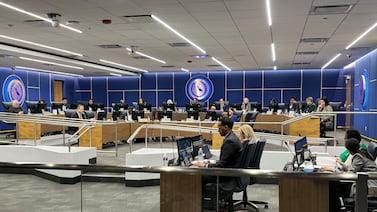Sign up for Chalkbeat Colorado’s free daily newsletter to get the latest reporting from us, plus curated news from other Colorado outlets, delivered to your inbox.
Three western Colorado communities hope to raise new dollars for child care through taxes paid by out-of-town visitors who stay in hotels or short-term rental housing.
La Plata and Grand counties and the City of Montrose all have lodging tax measures on the November ballot, with at least some of the proceeds intended to help make child care easier for local residents to find and pay for.
The three communities are the latest in a string of mostly mountain resort areas to ask voters for permission to spend lodging tax dollars on housing and child care. The idea is that local workers power the tourism industry, so visitors should contribute to efforts supporting a stable workforce.
The lodging-tax-for-child-care trend emerged in Colorado after a 2022 state law allowed counties and local marketing districts, which are created by communities to promote tourism, to use lodging taxes to support child care or housing, provided they get voter approval. Lodging taxes don’t typically raise huge sums in the context of local governments. But they offer a new stream of public money for child care at a time when a growing chorus of experts say it should be considered a public good, not a private burden.
Before the 2022 law went into effect, lodging taxes in counties and marketing districts had to be used for tourism efforts. Some Colorado cities and towns have long had the authority to levy a lodging tax to support child care, but few have done so.
Currently, about a dozen counties, towns, or local marketing districts in Colorado levy lodging taxes that can be used for child care initiatives. Some use the proceeds for scholarships to help families pay tuition or wage bumps for teachers.
A few such ballot measures have failed. One such measure in the City of Pueblo in 2023 would have been the first lodging tax for child care in a non-resort region.
Among the lodging tax measures on the ballot this year, only La Plata County’s measure wouldn’t raise taxes. Instead, the measure would reallocate 70% of the existing revenue from the 2% tax to housing and child care. About $500,000 would go to child care each year.
Heather Hawk, executive director of the Early Childhood Council of La Plata County, said the money would help middle-income parents pay for infant and toddler care — the hardest-to-find child care in many communities. It would also boost teacher pay, possibly through annual stipends, and help fund child care center renovations or new buildings.
Hawk said child care is so expensive in the area that it routinely eats up 25 to 30% of family income.
“Being able to reallocate the lodging tax was the perfect opportunity … because it doesn’t increase our local taxes in a way that impacts the families that live here,” she said.
The City of Montrose will ask voters to increase the lodging tax from .9% to 6%, with about 17% of the revenue going to child care initiatives. That’s about $158,000 per year.
William Woody, communications manager for the city’s office of business and tourism, said housing and child care have for years been the two most pressing issues cited by residents who respond to the city’s community survey. The shortage of child care seats has even caused turnover at City Hall.
“We have employees here at the City of Montrose that have had to move to other places in the United States, closer to family ... because of lack of child care,” he said.
Woody said during the pandemic, Montrose saw an “influx of workers who left bigger communities to work remotely and find a place that is rural but still has all the amenities.”
But that growth made housing and child care even harder to find, he said.
Meanwhile, Grand County will ask voters both to boost the lodging tax from 1.8% to 2% and allow the county to use some of the proceeds for housing and child care. If the ballot measure passes, the tax would generate about $2.25 million a year. About 30% of that — or $675,000 a year — would go to housing, child care, or services that benefit visitors.
Christine Travis, the county’s communications director, said how that 30% is spent could vary from year to year, with a housing initiative one year, a child care initiative the next, and so on.
She said Grand County commissioners have considered routing tax revenue to housing and child care for several years.
“Being a mountain resort community, affordable housing for the workforce and childcare to support that workforce has not been getting any easier over the years,” Travis said.
Ann Schimke is a senior reporter at Chalkbeat, covering early childhood issues and early literacy. Contact Ann at aschimke@chalkbeat.org.





